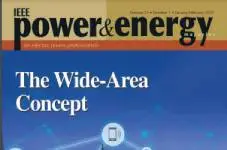Wind Energy Systems Sub-Synchronous Oscillations: Events and Modeling
Yunzhi Cheng, Lingling Fan, Jonathan Rose, John Schmall, Fred Huang, Jayanth R. Ramamurthy, Adi Mulawarman, Pratap G. Mysore, Zhixin Miao, Yin Li, Yangkun Xu, Miao Zhang, Shahil Shah, Przemyslaw Koralewicz, Robb Wallen, Vahan Gevorgian, Farshid Salehi, Mike Tabrizi, Wei-Jen Lee, Xiaorong Xie, Andrew Issac, Anuradha Dissanayaka, Pouya Zadkhast, Dustin Howard ,Ling Xu, Min Lwin, Ali Goharrizi, Bikash Pal, Husni Rois Ali, Linash Kunjumuhammed, Jian Sun, Yanfeng Gong, Ulas Karaagac, Jean Mahseredjian, Ilhan Kocar, Aramis Trevisan, Henry Gras, Richard Gagnon
-
Members: FreePES
IEEE Members: $45.00
Non-members: $70.00Pages/Slides: 155
Technical Report
15 Jul 2020
The first subsynchronous oscillation (SSO) in a type-3 wind farm with series compensated interconnection that caused severe damage was observed in Texas in 2009. Since then, analysis of the root causes and investigation of countermeasures have been carried out for such type of systems. Research indicates that such oscillations are due to radial connection of a type-3 wind farm to a series compensated line. Not only the doubly-fed induction generator (DFIG) contributes negative resistance at the LC resonance frequency, but also the rotor side converter control of the DFIG worsens the oscillations. Such incident was also reported back in 2007 in South Central Minnesota when a 100-MW wind plant was inadvertently left connected radially with a 345-kV series-compensated transmission line. In addition, from 2012 to 2013, Northern China observed oscillations due to a type-3 wind farm with radial connection to series capacitors.
In 2012, a type-4 wind farm located in Texas region experienced 4 Hz oscillations. In 2014 and 2015, oscillations at subsynchronous range were observed in Xinjiang, China. In both cases, the type-4 wind farms, however, do not have series compensated interconnections.
This taskforce report aims to present the real-world SSO events, mechanism of those dynamic phenomena, modeling practice carried out in the industry and academic research, and detection and mitigation strategies available in both industry and academic research.
The report has classified the wind farm SSOs into two types, with type-1 associated to Type-3 wind and series compensated networks and type-2 associated to wind farms in weak grids.
Aside from Chapter 1 (Introduction), the report includes five chapters. Chapter 2 presents real-world wind farm SSO events in Texas, Minnesota, and China. The modeling practice chapter (Chapter 3) includes various electromagnetic transient (EMT) testbeds that have been developed to replicate and analyze wind farm SSO as well as small-signal stability analysis tools for SSO analysis. Among the small-signal analysis tools, both state-space model-based tools and impedance/admittance-based frequency-domain tools are presented.
Chapter 4 presents the state-of-the-art wind SSO study and screening methodologies suitable for large-scale grids. This chapter includes the practice from ERCOT, DNV GL, Electranix, GE, and Powertech Labs. The screening method is largely focused on SSO due to type-3 wind in series compensated network. Chapter 5 presents SSO detection and mitigation. A thorough summary of SSO detection is presented in Chapter 5.1. Turbine side converter control based SSO mitigation schemes are presented in Chapter 5.2 for the first type of SSO and in Chapter 5.3 for the second type of SSO.
The concluding remarks are presented in Chapter 6. Chapter 6 also points out the challenges on modeling power grids with high penetration of converter interfaced resources.
In 2012, a type-4 wind farm located in Texas region experienced 4 Hz oscillations. In 2014 and 2015, oscillations at subsynchronous range were observed in Xinjiang, China. In both cases, the type-4 wind farms, however, do not have series compensated interconnections.
This taskforce report aims to present the real-world SSO events, mechanism of those dynamic phenomena, modeling practice carried out in the industry and academic research, and detection and mitigation strategies available in both industry and academic research.
The report has classified the wind farm SSOs into two types, with type-1 associated to Type-3 wind and series compensated networks and type-2 associated to wind farms in weak grids.
Aside from Chapter 1 (Introduction), the report includes five chapters. Chapter 2 presents real-world wind farm SSO events in Texas, Minnesota, and China. The modeling practice chapter (Chapter 3) includes various electromagnetic transient (EMT) testbeds that have been developed to replicate and analyze wind farm SSO as well as small-signal stability analysis tools for SSO analysis. Among the small-signal analysis tools, both state-space model-based tools and impedance/admittance-based frequency-domain tools are presented.
Chapter 4 presents the state-of-the-art wind SSO study and screening methodologies suitable for large-scale grids. This chapter includes the practice from ERCOT, DNV GL, Electranix, GE, and Powertech Labs. The screening method is largely focused on SSO due to type-3 wind in series compensated network. Chapter 5 presents SSO detection and mitigation. A thorough summary of SSO detection is presented in Chapter 5.1. Turbine side converter control based SSO mitigation schemes are presented in Chapter 5.2 for the first type of SSO and in Chapter 5.3 for the second type of SSO.
The concluding remarks are presented in Chapter 6. Chapter 6 also points out the challenges on modeling power grids with high penetration of converter interfaced resources.
Chairs:
Chair: Yunzhi Cheng, ERCOTCo-Chair: Lingling Fan, University of South Florida
Primary Committee:
Analytic Methods for Power Systems Committee (AMPS)
Sponsor Committees:
Transient Analysis and Simulations Subcommittee (TASS), Wind SSO Task Force



